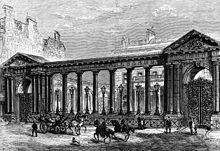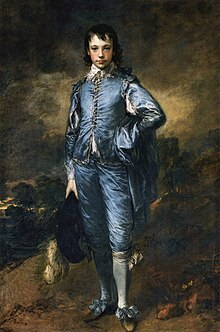Robert Grosvenor, 1st Marquess of Westminster
Robert Grosvenor, 1st Marquess of Westminster , KG (born March 22, 1767 in London , † February 17, 1845 in Eaton Hall , Cheshire ) was an English nobleman and politician. He was the son of Richard Grosvenor, 1st Earl Grosvenor , whom he followed in 1802 as Earl Grosvenor . In 1831 he became Marquess of Westminster . He was a member of the British Parliament (MP) and the ancestor of today's Dukes of Westminster . Grosvenor had the family's London estate expanded and the family's country house, Eaton Hall in Cheshire, rebuilt and its gardens restored. He also built a new residence in London, Grosvenor House . He increased the family's fortune through the purchase of works of art and horse breeding and racing.
Personal history
Robert Grosvenor was the third son and only surviving child of Richard Grosvenor, 1st Earl Grosvenor and initially carried the title Viscount Belgrave . He received his education at Westminster School , Harrow and Trinity College , Cambridge , where he received a Master of Arts degree in 1786 . His private tutor was the poet William Gifford . From 1786 to 1788 he made the Grand Tour with Gifford . Gifford described Grosvenor as a most lovable and accomplished student.
In 1794 Grosvenor married Eleanor Egerton, the only daughter of Thomas Egerton, 1st Earl of Wilton . The couple had four children: Richard , Lord Belgrave, was born in 1795 , who succeeded his father as title holder, in 1799 Thomas, who became 2nd Earl of Wilton after the death of his grandfather , and in 1801 Robert, who later became 1st Baron Ebury . One daughter, Amelia, died as a teenager.
Political and public life
In 1788 Robert Grosvenor was elected member of the East Looe constituency for two years . During this time he was appointed Lord of the Admiralty . In his first address to the House of Commons of Great Britain , he quoted the ancient Greek orator Demosthenes , which is why the satirist Peter Pindar called him the Lord of Greek . From 1790 to 1802 he was a member of the House of Commons for Chester . He raised a regiment of volunteers in Westminster to fight against France and was made its commanders in 1798. After his father's death in 1802, he became 2nd Earl of Grosvenor . From 1807 to 1808 he was mayor of Chester and there responsible for the construction of Northgate by the architect Thomas Harrison in 1810. From 1798 to 1845 he was Lord Lieutenant of Flintshire .
When Grosvenor entered Parliament, following family tradition, Grosvenor was a Tory and supported William Pitt . However, after Pitt's death in 1806, he changed his political affiliation and joined the Whigs . He supported the victims of the Peterloo massacre , the emancipation of Catholics , the abolition of the Corn Laws and voted for the Reform Act 1832 , according to which the constituencies were reallocated. Robert Grosvenor was considered a man of principles. He stood up for Queen Caroline , who was publicly humiliated and accused by her husband King George IV , and allegedly for this reason he threw a Bible or a prayer book at the king's head. When the Duke of Wellington was to be honored with the Freedom of the City of Chester, Grosvenor did not allow the town hall there to be used for this purpose.
Relations between Grosvenor and the king later improved, and in 1831 he was promoted to Marquess of Westminster .
Expansion of the family estate
Soon after Robert Grosvenor inherited the Eaton estate, he began rebuilding the Eaton Hall country home in Cheshire. He also began designing his land in London and creating new districts now known as Belgravia and Pimlico .
Eaton had become "an obsolete and rundown good ." The country house itself was designed by the architect William Samwell for Robert Grosvenor's grandfather, Sir Thomas Grosvenor, 3rd Baronet . Robert Grosvenor appointed William Porden as architect, who had recently also surveyed the London property. The original plan for the new house cost £ 10,000 (£ 750,000 in today's value) and then it would take two years to build. In fact, it took ten years to finish and it ended up costing £ 100,000 (£ 4,950,000 in today's value). The former house was completely rebuilt "in every possible implementation of the Gothic style ". The renovation included tourelles , pinnacles , arched windows, octagonal towers and buttresses , and four new wings were added to the house. When the future Queen Victoria visited the house in 1832 at the age of 13, she wrote in her diary: “The house is magnificent.” Others described it as “the most tasteless thing I have ever seen” or “a huge bunch of wannabees. Gothik [...], a monument of wealth, narrowness and bad taste ”.
To restore the gardens and grounds , Grosvenor hired landscape architect John Webb , a student of William Emes who planned the original grounds. New terraces have been built on the east side of the house, as well as a serpentine lake near the River Dee . The access road, Belgrave Avenue, was leveled, drained, and 130,000 trees were planted along it. The paths along the driveway were widened so that carriages could drive them. William Andrews Nesfield was hired to design more horticultural facilities, and he added more terraces, balustrades and flower beds with box hedges .
Grosvenor had a “fashionable new residential area” planned for his London property near what was then Buckingham House . He hired Thomas Cundy as the architect and Thomas Cubitt as the site manager. The Oxford Dictionary of National Biography states: "This urban development made the Grosvenors one of the wealthiest families in Great Britain." Grosvenor also bought other properties in Cheshire, Shaftesbury in Dorset and Stockbridge in Hampshire .
The family townhouse had been in Millbank , but in 1806 Robert Grosvenor bought a house in what is now Upper Grosvenor Street and had it enlarged considerably; this building became Grosvenor House . In addition, he had an art museum built in 1827. In 1843 Grosvenor House got a new entrance, which consisted of Doric columns between large gabled gates that separated the Cour d'honneur from the street, as was customary in Paris .
Personal hobbies
Grosvenor continued his family's interest in art and horse racing . He expanded the art collection by purchasing about four paintings by Peter Paul Rubens for £ 10,000 and Gainsborough's Boys in Blue for £ 100.
Robert Grosvenor also expanded horse breeding in Eaton. The best horse from Grosvenor's stable was Touchstone . The stallion won 16 of 21 races in which he started, including the St. Leger and twice the Ascot Gold Cup and the Doncaster Cup. He sired 323 foals, which won a total of around 700 races.
death
Robert Grosvenor died on February 17, 1845 at Eaton Hall and was buried in the family vault at St Mary's Church in Eccleston . His successor was Richard Grosvenor's son. In 1998, a memorial created by Jonathan Wylder was erected in Belgrave Square , London. At the foot of the monument is a quote from John Ruskin : " When we build, we should imagine that we will build for eternity." (Originally: "When we build let us think we build for ever." )
literature
- Diana Newton, Jonathan Lumby: The Grosvenors of Eaton. Jennet Publications, Eccleston, Cheshire 2004, ISBN 0-9543379-0-5 .
- Marion Mako: The Gardens at Eaton Hall. Eaton Estates, Eaton 2009.
Web links
- Robert Grosvenor at Hansard (English)
Individual evidence
- ^ Grosvenor, the Hon. Robert, afterwards Marquess of Westminster . In: John Archibald Venn (Ed.): Alumni Cantabrigienses . A Biographical List of All Known Students, Graduates and Holders of Office at the University of Cambridge, from the Earliest Times to 1900. Part 2: From 1752 to 1900 , Volume 3 : Gabb – Justamond . Cambridge University Press, Cambridge 1947, pp. 163 ( venn.lib.cam.ac.uk Textarchiv - Internet Archive ).
- ↑ a b c d e f g h i H. R. Tedder / HCG Matthew: Grosvenor, Robert, first marquess of Westminster (1767-1845). In: Oxford Dictionary of National Biography . Oxford University Press. Retrieved April 12, 2010.
- ↑ a b c d e f Newton / Lumby: The Grosvenors of Eaton. P. 21.
- ↑ Peerage: Westminster on leighrayment.com.
- ^ A b c d Newton / Lumby: The Grosvenors of Eaton. P. 24.
- ↑ London Gazette v. September 9, 1831 ( page no longer available , search in web archives ) Info: The link was automatically marked as defective. Please check the link according to the instructions and then remove this notice. Retrieved April 20, 2010.
- ^ Mako: The Gardens at Eaton Hall. P. 16.
- ^ Newton / Lumby: The Grosvenors of Eaton. P. 22.
- ^ Newton / Lumby: The Grosvenors of Eaton. Pp. 22, 24.
- ^ Mako: The Gardens at Eaton Hall. Pp. 14, 16.
- ^ A b c d Newton / Lumby: The Grosvenors of Eaton. Pp. 21-22.
- ^ Grosvenor House was demolished after the First World War; in its place is now the Grosvenor House Hotel .
- ↑ Belgrave Square on webcitation.org ( August 8, 2008 memento on WebCite ). Retrieved April 12, 2010
| personal data | |
|---|---|
| SURNAME | Grosvenor, Robert, 1st Marquess of Westminster |
| BRIEF DESCRIPTION | British nobleman and politician |
| DATE OF BIRTH | March 22, 1767 |
| PLACE OF BIRTH | London |
| DATE OF DEATH | February 17, 1845 |
| Place of death | Eaton Hall , Cheshire |




